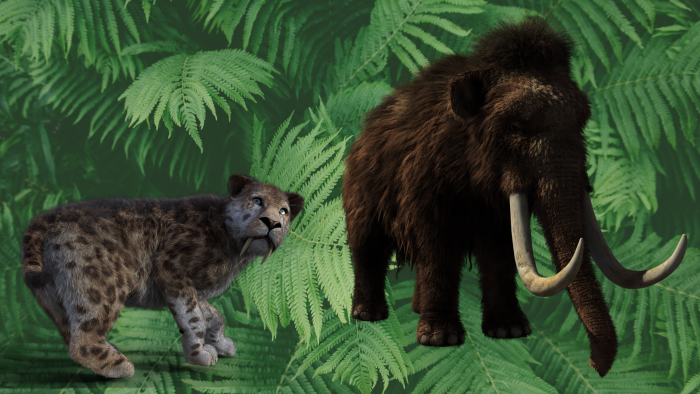
Prehistoric animals range from saber tooth tigers to wooly mammoths to giant apes, they spark our imagination and are a thrilling reminder of what our world used to be like.
When it comes to prehistoric animals, most people just have some notions of dinosaurs. Not only do most people study dinosaurs when they are kids, thanks to popular culture – most notably, the Jurassic Park franchise, dinosaurs have long captured people’s imaginations. But there were many more prehistoric animals.
“There are certain prehistoric things that swim beyond extinction.” — Karen Russell
Some of them were terrifying but others were so amazing that they would make you wish that they still existed.
These now-extinct animals once roamed the land or occupy oceans. Thanks to the work of archeologists and biologists, we can at least now get a scene of what these animals were.

So, here are the 10 prehistoric animals that make you wish you lived in the past:
The Gigantopithecus
One of the most fascinating prehistoric animals is the ape known as gigantopithecus, particularly the gigantopithecus blacki.
Despite its height and scary appearance (think of a really big orangutan), we know that this animal was mostly an herbivore. Scientists have surmised this from the jawbones and teeth they have found in Asia, chiefly in present-day Vietnam and China. There, it is believed that the gigantopithecus mostly ate bamboo. So, although this animal was big and scary-looking its diet seems to have been quite similar to that of the present-day Panda.
The Megatherium
Considerably cuter was the megatherium. This animal looked a lot like the present-day sloth if much bigger in size.
Scientists believe that the megatherium was as big as an elephant. In fact, the megatherium is believed to have been one of the biggest land mammals to have ever existed. It is estimated that its length was up to 20 feet (6 meters) and it could weigh as much as 4 tonnes.
“Science Fiction is not just about the future of space ships travelling to other planets, it is fiction based on science and I am using science as my basis for my fiction, but it’s the science of prehistory – plaeontology and archeology – rather than astronomy or physics.” — Jean M. Auel
Apparently, some megatheria could walk on two legs. The existence of this animal has been documented in South America.
The Glyptodon
The glyptodon was an animal that looked pretty much like an armadillo, only that it was considerably larger in size.
The main characteristic of the glyptodon is its large shell. It is also believed that this animal had a trunk it could move.
This prehistoric animal lived in the Pleistocene epoch (more than 10,000 years ago). Although related to armadillos, the glyptodon also looked a lot like a turtle.
The discovery of the glyptodon was recorded for the first time in Europe in 1823, although its fossils were actually found in the South American country of Brazil.
The Andrewsarchus Mongoliensis
This prehistoric animal gets part of its name from the country where its remains were located: Mongolia (the Valley of Jewels).
The andrewsarchus mongoliensis looked a lot like a wolf with very long sharp teeth, an eleven-foot length and weighed about 3700 pounds.
It is believed that this mammal was a carnivore, which would explain why they had big sharp teeth.
The Nuralagus Rex
This animal looked like a distant relative of rabbits.
The nuralagus rex would have looked like a huge, fat bunny rabbit. Its remains have been found in the Mediterranean island of Minorca (Balearic Islands).
It is believed that this animal became extinguished shortly after predators were introduced to the little island. The nuralagus rex was an herbivore which mostly enjoyed eating roots.
“Through the study of fossils I had already been initiated into the mysteries of prehistoric creations.” — Pierre Loti
The Arsinoitherium
This animal probably gets a lot closer to most people’s idea of a prehistoric animal that those that I have discussed so far probably do.
The arisnoutherium looked a lot like a dinosaur. But if I had to compare this prehistoric animal to a present-name animal, I would say that it looked like a rhinoceros with horns.
In fact, this prehistorical animal was related to sirenians, elephants, and hyraxes. It is believed that this herbivore creature lived in North Africa, which at the time (more than 30 million years ago) would have been covered by tropical forests.
The Rytiodus
This prehistoric animal is related to both the manatee and the dugong. And it did indeed share some characteristics with both of them. But the difference between the rytiodus and those two animals is its much larger size.
Apparently, this animal lived close to the seashore, could swim, and mainly fed itself by plowing sand and finding little ocean creatures.
Sometimes this animal is referred to as Steller’s sea cow.
The remains of the rytiodus have been found around Europe, most noticeably in present-day France, and in the North African country of Libya.
The Leviathan Melvillei
And talking about sea creatures, let me now introduced the leviathan melvillei.
This prehistoric creature had huge teeth that he used to tear other animals apart. But it is all in its name: Leviathan is an ocean demon in the Bible. And Melville is the name of the author of the American literary masterpiece Moby Dick, about the hunting down of the titular giant sperm whale.
The Diprotodon
This Australian prehistoric animal was, unsurprisingly a marsupial. In fact, it is believed to have been the largest marsupial creature in the world.
It is, therefore, believed that this creature must have looked quite similar to a koala but a lot bigger. Probably, about as big as a hippopotamus.
The diprotodon was most probably an herbivore.
The Machairodontinae
The last animal on our list is a feline that must have looked a lot like a tiger.
Remains of this prehistoric animal have been found in many continents:
- Asia
- Africa
- North America
- South America
- Europe
This long-extinct predator has been commonly described as a “saber-toothed cat.”
In fact, the name of this animal comes from the Greek for “dagger.”
Scientists have found out that the machairontinae fed mainly from horses and bison but also, sometimes, from mammoths, and ground sloths.
These are the 10 coolest animals that became extinct thousands of years ago. Which one (or ones) do you wish still existed?









